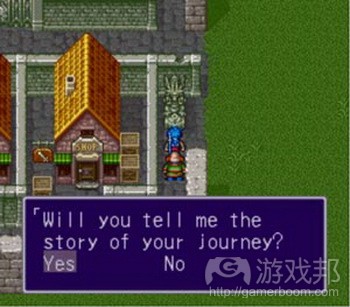分享游戏综合设计定义和案例说明
作者:Kevin
综合设计主要涉及引申意义。在完全综合的游戏中,所有内容都有其存在理由。我们看不到构成游戏的小要素,我们只能看到完整而富有沉浸性的游戏。
什么是综合设计?
综合设计是指赋予游戏各组成要素和物件游戏含义的设计。
赋予物件含义是指确保其在游戏世界中处于正确位置。物件不局限于墙面、平台、敌人、补充能量,还包括菜单、指南和保存屏幕。有些物件较难植入,有些甚至并不可行,或者植入此内容毫无意义。但在多数情况下,付出额外努力植入这些内容颇有价值,因为这能够创造更加丰富而有意义的游戏。
下面来看看两个例子:
例子一:《光晕》指南
在《光晕》系列首部作品开始,玩家扮演的Master Chief从低温睡眠中被唤醒。士兵指示其进行走走看看,履行日常检查例程。他掌握所有继续游戏所需的知识,但遗憾的是紧急情况促使他们无法通过武器测试,所以他们刚开始时没有武器。整个指南是紧凑场景的组成部分:苏醒,玩家学习控制角色,刚开始没有武器这些都是巧妙设计决策,都通过文本描述说明其在游戏中的存在理由。登陆指南完全融入游戏当中。这令玩家觉得自己是游戏世界的一份子,有助于营造游戏首个回合呈现的紧急情境。
例子二:《龙战士 2》保存系统
优秀传统游戏《龙战士 2》是另一典型例子(游戏邦注:该作品于1993年入驻Super Nintendo)。为保存游戏,玩家需向Dragon God雕像“讲述旅程故事”(从技术角度看,玩家将角色置于雕像前,点击按键,然后通过“是/否”菜单确认自己是否希望进行保存)。Dragon God和其他非玩家一样,通过相同对话框与玩家沟通,这样游戏便无需呈现不同界面,避免玩家脱离游戏世界的场景。此外,还要注意问题的组织方式,避免“保存”之类的术语,Dragon God自己将“向Dragon God祷告”的游戏机制呈现给玩家。
游戏故事告诉玩家新God试图通过游戏世界玩家的祈祷者获得力量。而Dragon God是旧God,大家不再向其祷告。令玩家通过频繁向Dragon God祷告,完成游戏保存操作,能够建立起玩家和Dragon God之间的联系,使其拒绝新的“邪恶”God。简单植入保存系统有利于将玩家放置在游戏故事中的适当位置,确认自己的抗争对象。若保存系统设置不当,不仅会呈现额外屏幕促使玩家离开游戏,还会令游戏丧失强大叙述技巧。
为什么要进行综合设计?
综合设计不仅涉及优化完整游戏。它还是个设计过程,是整体把握游戏的方式,应贯穿于游戏制作始末。这是个游戏设计哲学。设计师应留心游戏融入什么内容,询问自己:“此内容在游戏背景下是否行得通?若行不通,我如何赋予其正确位置,游戏含义?”
非综合游戏就像支离破碎的内容。玩家会指着不同内容称,“这是指南,这是补充能量,这给予我积分”。所有内容都会变得毫无意义。从历史观点看,当杰出游戏受到无限复制,游戏题材将自己确立为系列“功能”时,游戏词汇就会成为玩家文化的组成部分,他们开始将非综合游戏视作“正常”内容。他们知道什么是游戏指南,总会在开始新游戏的时候期待指南的出现。随着这些愿望的强化,以及较大型游戏所面临的资金压力,设计师通常被迫诉诸所谓的某题材秘诀,不再努力植入游戏要素。
这些现象促成此观点:电子游戏是我们根据“教条”强行植入的无意义内容(游戏邦注:而非让我们投入情感享受其中的游戏要素)。最终,你依然能够在不借助综合设计的情况下制作有趣游戏。玩家会喜欢游戏的挑战、其有趣机制和故事内容,但这些很难变成令人难忘的体验。完全综合的游戏会留给玩家更深刻的印象,因为内容非常自然、完整和富有意义。我们能够更容易记住完全综合的游戏体验,因为其包含较少分心内容及更多含义。
游戏邦注:原文发布于2009年9月2日,文章叙述以当时为背景。(本文为游戏邦/gamerboom.com编译,如需转载请联系:游戏邦)
Integrated Design for Games
By Kevin
Integrated design is all about the metaphor. In a fully integrated game, everything has a reason to be there. The tiny pieces that constitute the game are invisible, we can only see a game that is complete and involving.
What is integrated design?
“ Integrated design ” is a way to design that puts a special attention to giving meaning, in relation with the game’s metaphor, to every parts and objects that constitute the said game.
“To give meaning ”to an object is to ensure that it has it’s rightful place inside the game’s world. Objects are not reduced to walls, platforms, enemies, power-ups and such, but also include menus, tutorials, save screens, etc.. Some objects are harder to integrate than others and some are even almost impossible to or don’t benefit from integration. But in most cases they do and the extra effort done to integrate them is really worth it as it can create a richer, more meaningful game.
Let’s look at two examples :
Example #1: Halo’s tutorial
At the start of the first game of the Halo serie, the player, as Master Chief, is waken up from a cryogenic sleep. A soldier gets him to walk and look around as a test routine. He’s taken through all he needs to know to move in the game world but unfortunately the emergency situation prevents them from going through the weapon test routine and so he starts without weapons. The whole tutorial is part of a tight scenario: waking-up, the player learning to control the character and the fact that he starts with no weapons are all careful design decisions that were given reasons to be inside the game’s world through the scripted narrative. The entry tutorial is perfectly integrated into the game. This helps the player feels like he is a part of the game’s world and contribute to setting the mood of emergency present in the first chapter of the game.
Example #2: Breath of Fire II’s saving system
Here’s another good example of integration from the good old Breath of Fire II (originally released on the Super Nintendo console in 1993). To save his game, the player has to “tell the story of his journey” to a statue of the Dragon God (technically, he places his character in front of the statue, presses a button and then confirm he wants to save through a “yes \ no” menu). The Dragon God adresses the player with the same dialog box as any other non-player character would, this way avoiding the need for a different interface that would take the player away from the game world. Also, the question is phrased so as to avoid technical terms like “saving” and the system is introduced to the player, by the Dragon God himself, as “praying to the Dragon God”.
The game’s story tells the player of a new God trying to gain strenght from the prayers of the world’s inhabitant. In opposition, the Dragon God is an old God to which people don’t pray to anymore. By making the player pray frequently to the Dragon God in order to save his game, it creates a bounding between the player and the Dragon God, thus forcing him to reject the new, “evil” God. This simple integration of the saving system goes a long way to position the player in the game’s story and to confirm what he is fighting against. If the saving system were not integrated (let’s say the player would have to save through a menu entry of his character menu), this would not only create an extra screen to take the player away from the game, but it would also deprive the game of a powerful narrative technique.
Why would I want to do an integrated design?
Integrated design is not just about polishing a completed game. It is a design process, a way to look at the game as a whole, that should be used from the start of the project until it’s very end. It’s a design philosophy. The designer should always be aware of what goes into the game and ask himself “does this piece make sense in the context of the game? If not, how can I give it it’s rightful place, it’s meaning?”
A non-integrated game feel like it’s broken into many pieces. The player can point at the different parts and say “this is a tutorial, this is a power-up, this gives me points”. Everything starts to feel mechanical. Historically, as the great games got endlessly copied and game genres established themselves as a serie of “features”, the game’s vocabulary became a part of the players’ culture and they started to see non-integrated games as a “normal”. They KNOW what a tutorial is and often EXPECT one when starting up a new game. With these expectations building up and the financial pressure of ever bigger games, designers are often forced into applying a known genre-bound recipe. Any efforts to integrate the game’s pieces are often leaved behind.
These phenomenons perpetuate an ideology that video games are meant to be mechanical pieces that we overcome with brute force rather than pieces of art we enjoy with feelings. In the end you can still make enjoyable games without using an integrated design. The players will love the game for the challenges, the fun mechanics and maybe even the story, but it will be difficult to see those games as memorable. A fully integrated game will stick out much more in the player’s memory because it is unobstrusive, complete and meaningful. It is easier to remember a fully integrated experience because it contains less distractions and much more meaning.(Source:gamesandmen)
上一篇:游戏设计的先决条件:平台和体验
下一篇:幽默的音效设计可驱散玩家的厌倦感








































 闽公网安备35020302001549号
闽公网安备35020302001549号